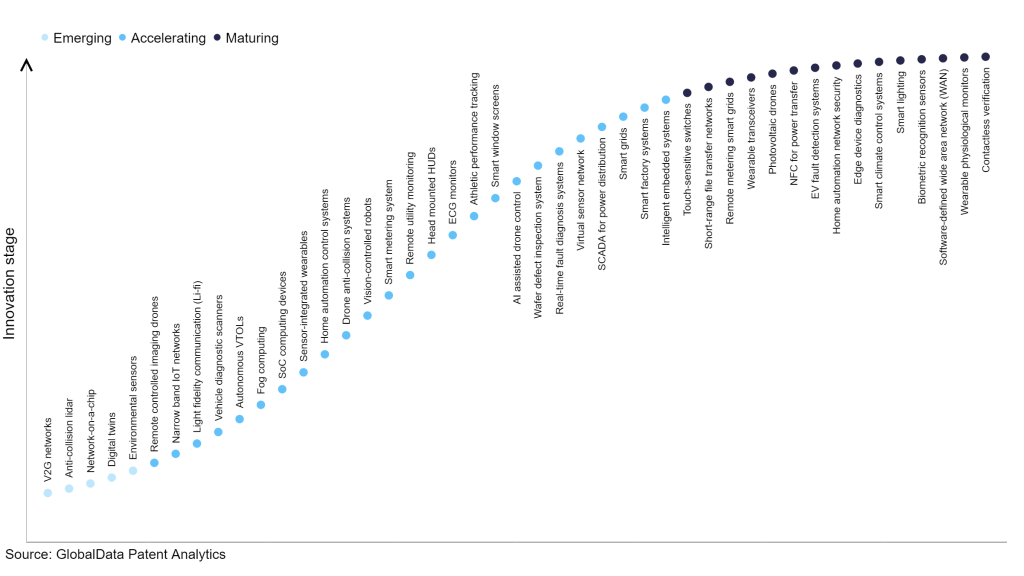The technology industry continues to be a hotbed of innovation, with activity propelled by factors such as the growing adoption of Internet of Things (IoT) devices, the increasing health consciousness among individuals, the demand for personalised and data-driven experiences, and the advancements in sensor technology. The growing importance of technologies such as miniaturised sensors, wireless connectivity such as Bluetooth and Wi-Fi, and data analytics platforms further supports innovation in the industry. These technologies work in synergy to collect, transmit, and analyse data, providing valuable insights and enhancing the functionality and effectiveness of wearables. In the last three years alone, there have been over 3.6 million patents filed and granted in the technology industry, according to GlobalData’s report on Innovation in Internet of Things: Sensor-integrated wearables. Buy the report here.
However, not all innovations are equal and nor do they follow a constant upward trend. Instead, their evolution takes the form of an S-shaped curve that reflects their typical lifecycle from early emergence to accelerating adoption, before finally stabilising and reaching maturity.
Identifying where a particular innovation is on this journey, especially those that are in the emerging and accelerating stages, is essential for understanding their current level of adoption and the likely future trajectory and impact they will have.
300+ innovations will shape the technology industry
According to GlobalData’s Technology Foresights, which plots the S-curve for the technology industry using innovation intensity models built on over 2.5 million patents, there are 300+ innovation areas that will shape the future of the industry.
Within the emerging innovation stage, environmental sensors, digital twins, and network-on-a-chip are disruptive technologies that are in the early stages of application and should be tracked closely. Intelligent embedded systems, smart factory systems, and smart grids are some of the accelerating innovation areas, where adoption has been steadily increasing. Among maturing innovation areas are contactless verification, wearable physiological monitors, and software defined wide area network, which are now well established in the industry.
Innovation S-curve for IoT in the technology industry

Sensor-integrated wearables is a key innovation area in IoT
Sensor-integrated wearables are wearable IoT devices embedded with electronic components and sensors to monitor and measure physical activities, biometrics, and environmental conditions. These devices, including fitness trackers, smartwatches, smart clothing, and medical devices, are designed to be worn on the body. They enable individuals to track and monitor various aspects of their health and lifestyle.
GlobalData’s analysis also uncovers the companies at the forefront of each innovation area and assesses the potential reach and impact of their patenting activity across different applications and geographies. According to GlobalData, there are 50+ companies, spanning technology vendors, established technology companies, and up-and-coming start-ups engaged in the development and application of sensor-integrated wearables.
Key players in sensor-integrated wearables – a disruptive innovation in the technology industry
‘Application diversity’ measures the number of different applications identified for each relevant patent and broadly splits companies into either ‘niche’ or ‘diversified’ innovators.
‘Geographic reach’ refers to the number of different countries each relevant patent is registered in and reflects the breadth of geographic application intended, ranging from ‘global’ to ‘local’.
Patent volumes related to sensor-integrated wearables
Source: GlobalData Patent Analytics
Apple is one of the leading patent filers in sensor-integrated wearables. One of the company's patents focuses on a haptic actuator comprising a housing with a recess, where a coil and a field member with a permanent magnet are positioned. The field member is supported by flexure bearings, allowing it to move within the housing in response to the coil. Other prominent patent filers in the space include Samsung Group and LG.
In terms of geographical reach, Amer Sports leads the pack, followed by SMK and Nokia. In terms of application diversity, Proxy holds the top position, followed by Omron and Nitto Denko.
IoT innovation in sensor-integrated wearables has revolutionized the landscape of wearable devices by seamlessly integrating sensors to gather and transmit real-time data. This advancement enables wearables to monitor various aspects such as health and fitness, environmental conditions, and location tracking.
To further understand how IoT is disrupting the technology industry, access GlobalData’s latest thematic research report on Internet of Things – Thematic Research.
Data Insights
From

The gold standard of business intelligence.
Blending expert knowledge with cutting-edge technology, GlobalData’s unrivalled proprietary data will enable you to decode what’s happening in your market. You can make better informed decisions and gain a future-proof advantage over your competitors.







